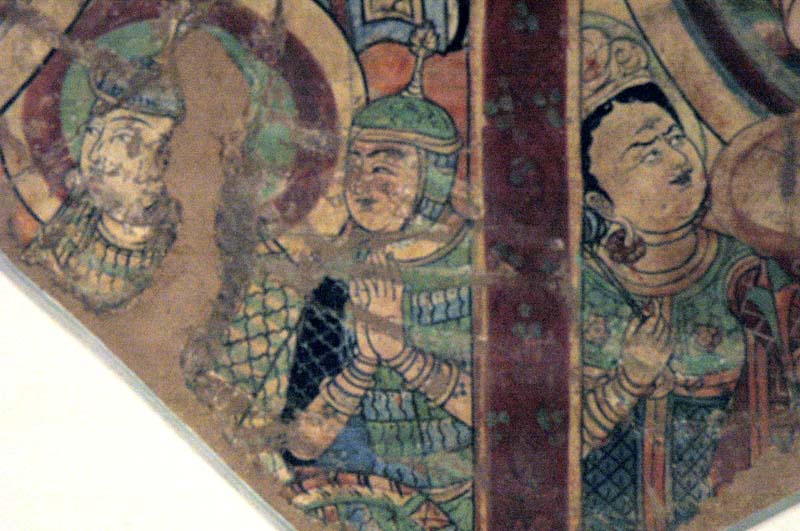
Try Amazon Audible Premium Plus and Get Up to Two Free Audiobooks
Wall Painting of Warriors
from Tumshuk, Tarim Basin

The full image of this Wall Painting of Budda Preaching and Warriors from Tumshuk, Tarim Basin.


On the left the remains of a Buddha mandorla are visible. In front of it, to all appearances, stands a knight whose helmet is an unusual sort of Spangelhelm. The nimbus round his head sets him off from another, younger man to the right, with lamellar armor and a conventional helmet.
A detail from scenes of the Buddha Preaching - Tumshuk, east spur, Socle Temple. Carbon14 date: 673-785. Wall painting. 51 x 75 cm. MIK III 8716 Published: Along the Ancient Silk Routes. Central Asian Art from the West Berlin State Museums (New York: Metropolitan Museum of Art, 1982), no. 42, p. 109. Source.
Referenced as figure 67 in The military technology of classical Islam by D Nicolle
67. Fresco from Eastern Temple, Tumsuk, late 6th century AD, east Turkistānī (in situ. ex-Stein S).
p222 Plumes are easier to pin down. In 10th century Khurāsān they were known as par santīz.59 They are also very common in the pictorial sources. This is particularly true of the eastern regions, both Islamic and non-Islamic, from where the tall helmet plume or feather may have spread west as part of a general adoption of Persian or Central Asian military fashions 618, 67, 90, 91, 196, 330, 422, 439, 455, 464, 574 and 651).
59. Firdawsī, op. cit., p. 427
618. Helmet from Gnezdovo, 10th century AD, Kievan Russian, State Hist. Museum, Moscow (Kir M).
90. Silvered dish, Isola Rizza Dish, late 6th-early 7th centuries AD, Byzantine or Lombardo-Byzantine, Castelvecchio Museum, Verona (Hes).
91. Bronze brow-plate of a helmet, late 6th-early 7th centuries AD, Lombardo-Byzantine, Bargello, Florence (Gui, Dix).
196A to 196D. Silver plates, A - 'Israelites, Goliath and Philistines,' B - 'David with Saul's armour,' C - 'Saul's soldiers,' D - 'David annointed,' The David Plates 613-629 AD, Byzantine, Metropolitan Museum, New York (WRW).
330A to 330I. Rock-cut statue, early 7th century AD, Sassanian, in it Ṭāq-i Bustān (Fuk).
422A to 422X. Manuscript, Warqa wa Gulshāh, 12th century AD, Azarbayjān, Topkapu Lib., Ms. Hazine 841, ff. 13/15a, 3/6a, 3/6a, 4/7b, 7/9b, 8/10b, 9/11a, 10/12a, 11/13a, 12/13b, 13/15a, 17/18a, 20/20a, 22/21b, 23/22a, 24/23b, 24/25b, 37/35a, 38/36b, 39/37b, 40/38b, 43/40a and 69/66a, Istanbul (Malik).
455. Statuette from Sorcuk, 8th century AD, east Turkistānī, Museum für Völk., Staatliche Museen Dahlem, West Berlin (Coq).
464. Painted paper fragment from Yār, 9th century AD, east Turkistānī, Staatliche Murseen Dahlem, West Berlin (Coq).
574. Relief, late 11th century AD, Italo-Norman, in situ, Church of San Bernadetto, Brindisi.
651. Manuscript, Astrology of Abū Maʿshar al Balkhī, early 14th century AD , Egyptian (?), Bib. Nat., Ms. Ar. 2583, Paris. (Hal).